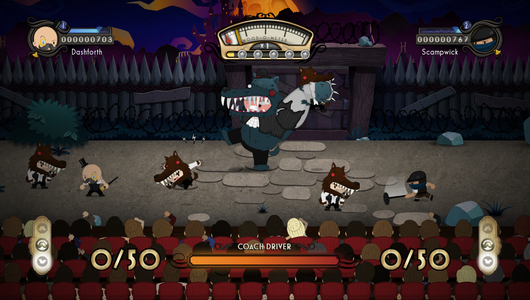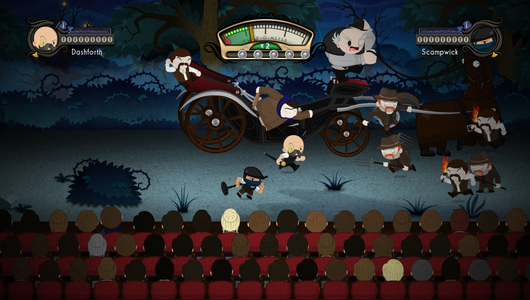Baron Dashforth is a Deamon-Hunter — and a proper English gentleman — He has decided to put on a show detailing the most spectacular and amazing moments of his life. Joined by his sidekick Scampwick, they will play themselves (for who else would be suitable) in this sidescrolling brawler of daemonic proportions. But all is never as simple as it seems as Dashforth and Scampwick know better than any to always expect Foul Play.
• Developer: Mediatonic
• Publisher: Devolver Digital
• Reviewed on: Xbox 360
• Also Available On: Steam
• Release Date: September 18th
Foul Play is a funny and enjoyable sidescrolling brawler set in the early 1900’s in Victorian England. Baron Dashforth has decided to put on a play detailing the events of his life and the fantastic art style represents this accordingly. As you move from scene to scene props and backgrounds will be pulled off stage to be replaced by new ones. Enemies too are quite obviously part of the show as they are all actors in suits. You can see a man’s eyes and nose from within his daemon squid suit or sometimes after an enemy is defeated he will quickly crawl off the stage. There are many humorous moments such as the maintenance man still hanging up a prop when the scene changes or a crook coming in from off-screen to hook defeated enemies and pull them away.
I think the best way to describe the action in Foul Play would be to imagine if Castle Crashers and Guitar Hero had a baby. Though it’s a sidescroller there is an element of three dimensional play to it as you can move up and down the stage, not just left and right. The combat is fun but can get quite repetitive after a while. You get some basic moves from the beginning like quick attack, heavy attack and dodge. As the game progresses you unlock new moves like a parry and charged attacks , as well as combo moves, such as a mid air parry that can be turned into an area of effect piledriver. Despite the apparent variety of attacks I found that after about half way I was using the same 3 or 4 combos over and over again as they were far more effective than the rest, including the moves you get towards the end of the game – which went almost completely unused.
Foul Play eschews traditional health and damage meters for a crowd mood-o-meter. This is where the Guitar hero comparisons come in as the meter acts just like the crowd meter in GH. As you take hits the crowds happiness level will drop and the only way to raise it again is to land hits and combos, and if the meter hits zero it’s curtains for your performance. Combos are essential for getting a good rating (you are rated out of five stars at the end of a level) as keeping the mood-o-meter high will keep a score multiplier going. There are also three challenges associated with each level. These range from getting a perfect scene (not dropping a combo for a whole encounter), getting a certain amount of hits in a combo, or beating enemies in a certain order and more. These challenges help keep the repetitive combat from becoming too boring by giving you something to aim for in each act. You can also unlock charms for completing all the challenges in an act. Charms are basically perks and can range from making a combo last longer between hits to the mood-o-meter draining less when you take a hit.
One of the biggest disappointments of Foul Play is its lack of game mode variety as it boasts only a story mode and nothing else. A time attack mode would have been great and well suited or perhaps an arcade mode where players compete for the highest score, however without any of these the game is left feeling very bare and after the story is finished there is very little replay value unless you’re a perfectionist and want to get all the achievements or five stars on every level. There are leaderboards which track the players total score and biggest combo across each play but without any competitive element in other game modes they don’t add much to the game. There is also no difficulty setting which would have helped a lot as I found most encounters to be reasonably easy and only one boss caused me any trouble – though even he didn’t manage to defeat me. Being able to up the difficulty for a greater challenge would have been nice.
The story is laid out in a series of five plays and acts – with the first four plays having five acts and the final play having two, for a total of twenty two levels. All told it took me about six hours to complete the game. Local and online co-op are also featured with the second player taking control of Scampwick. In co-op you can link attacks together, equip charms that complement each other and more things besides. Co-op is par for course with this kind of game, however it is limited to two player where other similar games often feature four. This is not a negative, as adding another two players would have taken away from the idea of the whole thing being a play about Dashforth and Scampwick and was preferable to just adding two random characters.

The Deamon Diary is one of the best aspects of the game. As you complete Acts and Plays you unlock pages in each section of the Diary. These include Dashforth’s father’s diary from before he disappeared, a diary from Dashforth himself and an encyclopaedia of all the bosses you have defeated penned by Scampwick. Each of these of these are very interesting in their own right, the diaries provide context and back story to the rest of the game and Scampwick’s musings on the Daemons are more often than not, hilarious.
I only gave this game a three because I feel it is missing some key components like difficulty and other mode options as well as the combat being repetitive. However you should consider it a high three and if it had a few of the things I mentioned it would definitely be a four. But even with these problems the game is still highly enjoyable with a fun style, excellent humour and a good story. However when playing this game you should always remember to expect Foul Play.









